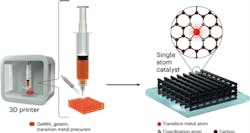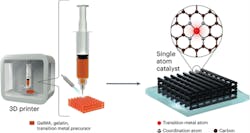Researchers Use 3D Printing to Produce Single-Atom Catalysts
Using 3D printing, researchers in Australia have developed a novel technique to produce customized single-atom catalysts (SACs).
SACs are materials with isolated metal atoms as active sites, anchored by scaffold-like surrounding coordination species of solid supports. Their advantages include high atom economy and tunable coordination properties, giving huge potential for use in many industrial processes. However, they are expensive and tricky to synthesize.
What researchers at the University of Adelaide’s Centre for Materials in Energy and Catalysis have done is take the SAC precursors, including natural polymers and transition metals, and mix them to form printing ink. Then, the scaffold is 3D printed. After calcination and subsequent post-treatments, isolated individual atom sites anchored on carbon supports were achieved (Figure 1). These were tested by converting nitrate ions in wastewater to ammonia.
According to Fangxi Xie, a postdoctoral research fellow in the university’s School of Chemical Engineering and Advanced Materials, the team is currently working to further explore the potential of SACs in other reactions critical for the chemical industry.
“Specifically, our team has successfully employed different electrocatalysts in different reactions over the past few years. One notable example is the development of a new kind of catalyst that more efficiently generates hydrogen for clean energy from urea-rich wastewater,” Xie explains.
“Furthermore, we have recently developed a non-precious and cost-effective catalyst capable of splitting natural seawater into oxygen and hydrogen with nearly 100% efficiency, enabling the production of green hydrogen through electrolysis,” he adds.
In terms of the 3D printing process for producing SACs, the team is working with both natural polymers and metal complexes. The natural polymers have proved very successful and are commercially available and easily accessible by researchers, notes Xie. However, he says the cost of metal complexes might pose a challenge for scaling up production. “We are exploring the possibility of using more affordable metal precursors to reduce the overall cost,” he emphasizes.
Another concern from an engineering perspective, Xie adds, is the temperature control of the printing ink. However, future upgrades to the 3D printer will address this, he believes.
This simplified way of developing advanced catalysts has already attracted interest from several industrial companies.
“In my opinion, this new avenue is expected to accelerate the development of single-atom catalysts and make them technically and economically available for the chemical engineering industry within 10–15 years,” Xie concludes.
About the Author
Seán Ottewell
Editor-at-Large
Seán Crevan Ottewell is Chemical Processing's Editor-at-Large. Seán earned his bachelor's of science degree in biochemistry at the University of Warwick and his master's in radiation biochemistry at the University of London. He served as Science Officer with the UK Department of Environment’s Chernobyl Monitoring Unit’s Food Science Radiation Unit, London. His editorial background includes assistant editor, news editor and then editor of The Chemical Engineer, the Institution of Chemical Engineers’ twice monthly technical journal. Prior to joining Chemical Processing in 2012 he was editor of European Chemical Engineer, European Process Engineer, International Power Engineer, and European Laboratory Scientist, with Setform Limited, London.
He is based in East Mayo, Republic of Ireland, where he and his wife Suzi (a maths, biology and chemistry teacher) host guests from all over the world at their holiday cottage in East Mayo.


